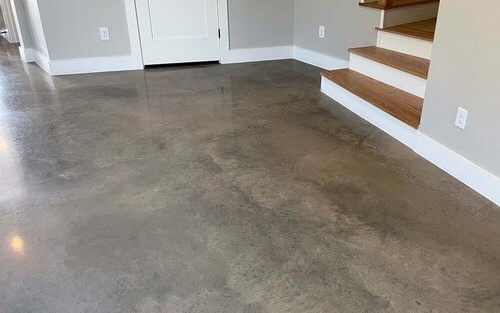Concrete Floor Staining Services
Comparison of Concrete Stains vs. Concrete Dyes
Concrete dyes and stains have become the latest trend in the concrete decorative community. Thanks to their ease of use and an extensive palette of vibrant colors, they are replacing acid stains.
Concrete Stains and Concrete Dyes
Concrete stains and dyes do not react with the concrete but contain pigments that penetrate into the surface. Their common features:
- Unlimited Color Palette – color is practically unlimited because you can mix of dilute the colors.
- Safe Application – The application of water-based stains or dyes is easy and safe for contractors, as will as homeowners. They contain no or very low VOCs. A quick application with a low-pressure sprayer, roller, brush or sponge.
Concrete Dyes
Dyes are used to color most everyday product, including textiles, plastics, wood, paper, and food, as well as concrete. Natural dyes originate from plant sources like berries, roots, wood, an fungi. The invention of synthetic dyes has vastly increased the range of colors. Concrete dyes have become available in stores in the form of liquid concentrates or powders.
Dyes contain very fine color pigments, much smaller than stains. They are solutions, similar to ink, and can easily penetrate into tight concrete. Most are water-based but there also are solvent-based dyes, usually with acetone or alcohol.
- Uniform Color – The resulting color is usually more uniform or monotone, unlike the variegated look of stains.
- Not UV-stable – Typically, dyes are not UV-stable and would fade in the sun in a couple of months, which limits them to interior use.
- Top Coatings – most manufacturers recommend applying a clear sealer to lock in the color and protect against leaching.
Concrete Stains
Concrete stains are a suspension of color pigments. This is similar to paints but the stain pigments must penetrate into the concrete instead of staying on the surface, or they would wear or wash off. Concrete stains are typically water-based and have none or a low VOC content. Easy and safe application.
More porous areas will absorb more pigments, making them darker. Tighter concrete will absorb less of the stain pigments. Hard-troweled concrete requires good surface preparation to open up the surface and make it sufficiently porous.
Concrete stains provide a vibrant, variegated look on the concrete, similar to acid stains but with many more color options.



